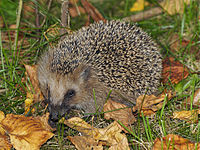
Photo from wikipedia
The rehabilitation of sick or injured wildlife and their subsequent release back into the wild is considered important, not only for the welfare of the individual animal but also for… Click to show full abstract
The rehabilitation of sick or injured wildlife and their subsequent release back into the wild is considered important, not only for the welfare of the individual animal but also for the conservation and management of endangered and threatened wildlife. The European hedgehog Erinaceus europaeus has declined by 25% in Britain over the last decade and is the most common mammal admitted to wildlife rehabilitation centres in Britain, with a large proportion of individuals admitted to gain body weight overwinter prior to release in the spring. Consequently, many thousands of hedgehogs are housed overwinter which incurs significant costs for rehabilitation centres, and has potentially animal welfare issues, such as, stress in captivity, reintroduction stress, increased mortality risk and impaired or altered behaviour. To determine if releasing rehabilitated hedgehogs during autumn and winter had an effect on their survival, body weight or nesting behaviour, we compared these factors between 34 rehabilitated hedgehogs with 23 wild hedgehogs across five sites in England over four different winters. Overwinter survival was high for both wild and rehabilitated hedgehogs, with a significant decrease in survival across both groups when hedgehogs became active post hibernation in spring. We found no differences in the survival rates up to 150 days post release, in weight change, or nest use between wild- and winter-released rehabilitated hedgehogs. Our results suggest that under the correct conditions, rehabilitated hedgehogs can be released successfully during winter, therefore avoiding or reducing time in captivity.
Journal Title: European Journal of Wildlife Research
Year Published: 2018
Link to full text (if available)
Share on Social Media: Sign Up to like & get
recommendations!